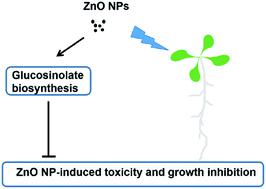当前位置:
X-MOL 学术
›
Environ. Sci.: Processes Impacts
›
论文详情
Our official English website, www.x-mol.net, welcomes your
feedback! (Note: you will need to create a separate account there.)
Involvement of glucosinolates in the resistance to zinc oxide nanoparticle-induced toxicity and growth inhibition in Arabidopsis
Environmental Science: Processes & Impacts ( IF 4.3 ) Pub Date : 2021-6-1 , DOI: 10.1039/d1em00134e Han Tao 1 , Songshen Hu 2 , Chuchu Xia 1 , Mengyu Wang 1 , Tonglin Wang 3 , Wei Zeng 1 , Yubo Li 1 , Hao Chen 1 , Jirong Zheng 3 , Qiaomei Wang 1
Environmental Science: Processes & Impacts ( IF 4.3 ) Pub Date : 2021-6-1 , DOI: 10.1039/d1em00134e Han Tao 1 , Songshen Hu 2 , Chuchu Xia 1 , Mengyu Wang 1 , Tonglin Wang 3 , Wei Zeng 1 , Yubo Li 1 , Hao Chen 1 , Jirong Zheng 3 , Qiaomei Wang 1
Affiliation

|
Zinc oxide nanoparticles (ZnO NPs) are widely used to manufacture textile fibers, synthetic rubber, and paint. However, crop yields and quality are threatened by the increased use of metallic NPs in industry, which has resulted in their accumulation in agricultural land. Many studies have shown that plants defend against biotic and abiotic stresses through the activities of metabolites and hormones. However, whether glucosinolates (GSs) are involved in plant responses to ZnO NP-related stress remains unknown. In this study, wild-type (WT) and GS mutant (myb28/29 and cyp79B2/B3) Arabidopsis plants were subjected to ZnO NP stress to address this question. Our results showed that exposure to ZnO NPs promoted GS accumulation and induced the relative messenger RNA (mRNA) expression levels of GS biosynthesis-related genes. Moreover, ZnO NP treatment adversely affected root length, the number of lateral roots, chlorophyll contents, and plant biomass. Importantly, our results showed that root growth, chlorophyll contents, and plant biomass were all decreased in the GS mutants compared with those in WT plants. Overall, our results showed that WT plants tolerated ZnO NP-induced stress more efficiently than the GS mutants, suggesting that GSs are involved in plant resistance to ZnO NP-induced toxicity.
中文翻译:

芥子油苷对拟南芥中氧化锌纳米颗粒诱导的毒性和生长抑制的抗性
氧化锌纳米颗粒 (ZnO NPs) 广泛用于制造纺织纤维、合成橡胶和油漆。然而,作物产量和质量受到工业中金属纳米颗粒使用增加的威胁,这导致它们在农田中积累。许多研究表明,植物通过代谢物和激素的活动抵御生物和非生物胁迫。然而,硫代葡萄糖苷(GSs)是否参与植物对氧化锌纳米颗粒相关胁迫的反应仍然未知。在本研究中,野生型(WT)和 GS 突变体(myb28/29和cyp79B2/B3)拟南芥植物受到 ZnO NP 胁迫来解决这个问题。我们的结果表明,暴露于 ZnO NPs 促进了 GS 积累并诱导了 GS 生物合成相关基因的相对信使 RNA (mRNA) 表达水平。此外,ZnO NP 处理对根长、侧根数量、叶绿素含量和植物生物量产生不利影响。重要的是,我们的结果表明,与 WT 植物相比,GS 突变体的根生长、叶绿素含量和植物生物量均降低。总体而言,我们的结果表明,WT 植物比 GS 突变体更有效地耐受 ZnO NP 诱导的胁迫,表明 GS 参与植物对 ZnO NP 诱导的毒性的抗性。
更新日期:2021-06-21
中文翻译:

芥子油苷对拟南芥中氧化锌纳米颗粒诱导的毒性和生长抑制的抗性
氧化锌纳米颗粒 (ZnO NPs) 广泛用于制造纺织纤维、合成橡胶和油漆。然而,作物产量和质量受到工业中金属纳米颗粒使用增加的威胁,这导致它们在农田中积累。许多研究表明,植物通过代谢物和激素的活动抵御生物和非生物胁迫。然而,硫代葡萄糖苷(GSs)是否参与植物对氧化锌纳米颗粒相关胁迫的反应仍然未知。在本研究中,野生型(WT)和 GS 突变体(myb28/29和cyp79B2/B3)拟南芥植物受到 ZnO NP 胁迫来解决这个问题。我们的结果表明,暴露于 ZnO NPs 促进了 GS 积累并诱导了 GS 生物合成相关基因的相对信使 RNA (mRNA) 表达水平。此外,ZnO NP 处理对根长、侧根数量、叶绿素含量和植物生物量产生不利影响。重要的是,我们的结果表明,与 WT 植物相比,GS 突变体的根生长、叶绿素含量和植物生物量均降低。总体而言,我们的结果表明,WT 植物比 GS 突变体更有效地耐受 ZnO NP 诱导的胁迫,表明 GS 参与植物对 ZnO NP 诱导的毒性的抗性。











































 京公网安备 11010802027423号
京公网安备 11010802027423号